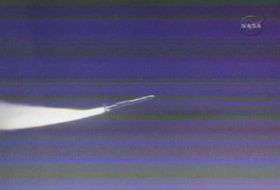NASA's AIM Cloud Mission Launches

NASA's AIM spacecraft began its two-year mission April 25, 2007 after a flawless ride to Earth orbit aboard an Orbital Sciences Pegasus XL rocket. Launch took place at 1:26 PDT. Launch operations at Vandenberg Air Force Base in California ran smoothly, with no technical or weather issues causing concern.
The AIM mission is the first dedicated to exploring mysterious ice clouds that dot the edge of space in Earth's polar regions. These clouds have grown brighter and more prevalent in recent years and some scientists suggest that changes in these clouds may be the result of climate change.
"The successful AIM launch initiates an exciting new era in understanding how noctilucent clouds form and why they vary," said Principal Investigator James M. Russell, III, of Hampton University in Hampton, Va. "The coordinated AIM measurements will provide the first focused and comprehensive data set needed to unravel the mysteries of these clouds."
Noctilucent clouds are increasing in number, becoming brighter and are occurring at lower latitudes than ever before. "Such variations suggest a connection with global change," said Russell. "If true, it means that human influences are affecting the entire atmosphere, not just the region near the Earth's surface."
The Stargazer L-1011 aircraft released a Pegasus XL rocket at a drop point over the Pacific Ocean, 100 miles offshore west-southwest of Point Sur, Calif. AIM was launched at an azimuth of 192.5 degrees into a circular polar orbit of 375 miles with an inclination of 97.7 degrees.
At approximately 1:36 p.m., communications from a Tracking Data and Relay Satellite confirmed spacecraft separation, and the solar arrays deployed autonomously soon thereafter.
The spacecraft was declared operating nominally at approximately 2:44 p.m., when it passed over the Svalbard, Norway, ground station. Spacecraft bus commissioning activities will be performed during the next six days while controllers verify satisfactory performance of all spacecraft subsystems.
Throughout a 30-day check-out period, all the spacecraft subsystems and instruments will be evaluated and compared to their performance during ground testing to ensure satisfactory operation in the space environment. The instruments will maintain their protective covers to shield the near pristine optical surfaces from contamination while the spacecraft outgases volatile materials. Fourteen days after launch, the optical covers will be removed in sequence by ground commands, and the instruments will begin scientific operations.
During the next two years, AIM scientists will methodically address each of six fundamental objectives that will provide critical information needed to understand cloud formation and behavior.
"This mission has many firsts, including that Hampton University is the first historically black college and university to have the principle investigator and total mission responsibility for a NASA satellite mission," said Program Executive Victoria Elsbernd, NASA Headquarters, Washington.
NASA's Kennedy Space Center, Fla., is responsible for launch vehicle/spacecraft integration and launch countdown management. NASA's Goddard Space Flight Center, Greenbelt, Md., is responsible for the overall AIM mission management in collaboration with Hampton University, the University of Colorado, Boulder, and Virginia Polytechnic Institute and State University, Blacksburg. Orbital Sciences Corporation, Dulles, Va., is responsible for providing the Pegasus XL launch service to NASA.
AIM is the ninth small-class mission under NASA's Explorer Program, which provides frequent flight opportunities for world-class scientific investigations from space within the heliophysics and astrophysics science areas.
Source: NASA





















